Creation: Darwinian Evolutionary Frauds Pt. II

A Sunday guest post by my brilliant husband, Gregg.
Every Sunday, my clever husband offers me a “day of rest” by writing posts on the subject of his primary ministry. This is a topic that is gaining more and more attention in our modern culture. The topic, Creationism vs. Darwinism, is a subject that has broad reaching scientific, social, and metaphysical implications. He chooses to conclude each post with a message intended to hearten and bolster believers. However, for believers and non-believers alike, the primary purpose is to present scientific, historical, logical, and/or sociological data in an empirical fashion, as much as possible written in layman’s terms, and in a format suitable for supplementing any homeschool curriculum whether you choose to believe the Biblical account — or secular guesses — about the origins of human life on earth.
Conflicting Worldviews
In the molecules-to-man model of Darwinian evolution, it must be assumed that massive amounts of new and useful information is added to organisms as subsequent generations appear. A molecule of dirt mixes with water for (use your big-booming announcer voice) “MILLIONS OF YEARS” until the magical fairy-godfather named “evolution” defies mathematical impossibility and waves his magic wand and transforms the dirt into a living cell.
That magical cell is what every Darwinists alive calls grandpa. So, I guess the dirt is great-grandpa and water is great-grandma. Anyway, according to the Darwinist worldview, grandpa cell becomes the original “seed” that grows over (big voice) “MILLIONS OF YEARS” into (biggest-booming announcer voice yet!) the “TREE OF LIFE!”
In the Darwinist molecules-to-man model, that first cell, our alleged original ancestor, is infused with additional and just massive amounts of new and useful information over (big voice) “MILLIONS OF YEARS” so that his progeny evolve into every living thing in the known universe from frogs to ferns and from apples to apes. What started out as great-grandpa rock, is now a living thing capable of decision making, reproduction, transforming nourishment into energy, healing when hurt, and all of the other multiple factors required for survival.
Take a moment to bleach your brain. I know I need one.
Okay. In the Biblical wordview, God created plants, animals, and man. As each plant and each animal –and also man–brought forth each within their own kind, the useful information within the genes that was passed on to subsequent generations resulted in yet more plants, animals, and people. However, instead of bananas slowly turning into grapefruits, the progeny that resulted from this fruitful effort each existed within the boundaries of their own kind and there was some simple variation within each kind.
Then, after the fall, error was introduced into God’s perfect creation. Thereafter, variation within each kind came with a slight loss of information. As subsequent generations brought forth, each within their own kind, information was lost along the way and this process accelerated after the global cataclysmic E.L.E. (extinction level event) known as the world wide flood which took place about 4700 to 5000 years ago.
Therefore, according to the Darwinist worldview, biological structures in living things that are often difficult to explain are the result of evolution. According to the Biblical worldview, those same biological structures are still serving a purpose — perhaps just in a diminished way as a result of the fall.
Vestigial Organs and Structures
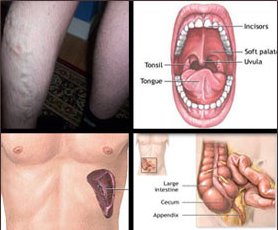 As far as biology goes, vestigial structures are probably the best example of Darwinian reliance upon circular reasoning to “prove” their alleged point, that point being that Darwinian evolution is “true.” Vestigial organs are also a very good example of intentional and continuing fraud perpetrated by Darwinists.
As far as biology goes, vestigial structures are probably the best example of Darwinian reliance upon circular reasoning to “prove” their alleged point, that point being that Darwinian evolution is “true.” Vestigial organs are also a very good example of intentional and continuing fraud perpetrated by Darwinists.
Vestigiality describes “homologous” characteristics of organisms that have seemingly lost either all or most of their original function in a species through the process of Darwinian evolution. This is a revised definition. Originally, they were said to serve no purpose in modern organisms, just the baggage of our ancestry. You see, Darwinists claim that these vestiges are leftovers from our distant ancestral evolution which are no longer useful or even needed. Supposedly, the best explanation for these nonfunctional traits is that they once served a purpose in our ancestor but now no longer do and serve as proof of evolution. The definition had to be revised as functions and purposes for these identified structures began to be known.
What Darwinists call vestigial structures today were also known to Charles Darwin, though the term did not yet exist when he published his racist diatribes. He referred to them as “rudimentary organs” instead. In his book entitled The Descent of Man and Selection in Relation to Sex, which otherwise primarily rationalizes Darwin’s particular brand of racism, that which we call separate evolution or the notion that certain “lower” races evolved separately from other “Favoured” races, he listed a number of rudimentary organs. He lists, for instance, the muscles of the ear, wisdom teeth, the appendix, the tail bone, and body hair.

Back in 1893, Darwinist and humanist Robert Ernst Wiedersheim published a list of 86 human organs that had, in his words, “lost their original physiological significance”. Theorizing that they were vestiges of evolution, he coined them “vestigial”. There. That sounds authoritatively scientific enough.
Later versions of Wiedersheim’s list were expanded to as many as 180 human “vestigial organs”. This is why the zoologist Horatio Newman stated in a written statement read into evidence in the 1925 Scopes Trial that “There are, according to Wiedersheim, no less than 180 vestigial structures in the human body, sufficient to make of a man a veritable walking museum of antiquities.”
This is what is known as an argument from ignorance or an argument from incredulity, depending on the context. Ignorance of the true purpose for the listed items, or an inability to personally imagine that they have a purpose, is the premise for this fallacious form of argument and you are meant to conclude that their belief is the only possible answer. Logically speaking, if Darwinian evolution is truly occurring, vestigial organs would not only exist, but they would greatly outnumber the fully functional organs. This is simple math.
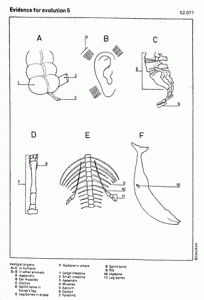 Even so, possibly the most interesting thing about Vestigial Organs or Vestigial Structures or whatever you want to call them — is that the list currently stands at ZERO.
Even so, possibly the most interesting thing about Vestigial Organs or Vestigial Structures or whatever you want to call them — is that the list currently stands at ZERO.
That’s right. The list of vestigial structures went from a whopping 180 items in 1925 at the Scopes trial all the way to a profound and resounding NONE by 1986, nearly 25 years ago. While mathematically, Darwinian evolution predicts millions of vestigial organs and structures, there are none identified for the human body.
Yet, they are still found in high school textbooks today. A web search turned up a current high school pop quiz.
Even though relevant and often vital functions have been identified for each and every one of the so-called “vestiges” of our alleged Darwinian evolutionary past, so-called vestigial structures are still held up as “proof” of evolution and still taught in public schools today as if they were factual. This activity can only be described as intentional fraud.
A Vestigial Fraud
It starts with the human embryo. According to the Biblical worldview, just over 3,000 years ago, King David, wrote about how God beheld his “unformed substance” in the womb (Psalm 139:16), and hearkens back to Job who states how he was knitted together step by step sinew by sinew (Job 10:10-11), all according to God’s plan. And David proclaims that he will praise God for he was “fearfully and wonderfully made.” (Psalm 139:14)
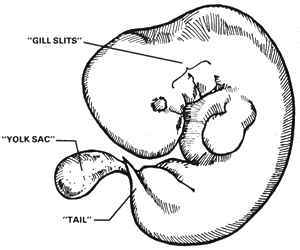 By contrast, according to the Darwinist worldview, students are told that human embryos in the womb have “vestigial structures” such as gill slits like a “fish,” yolk sacs like a “chicken,” and a vestigial tail like an “ape” that are all throwbacks to our evolutionary heritage. None of that is true, and has been known to be false for at least a quarter of a century or more.
By contrast, according to the Darwinist worldview, students are told that human embryos in the womb have “vestigial structures” such as gill slits like a “fish,” yolk sacs like a “chicken,” and a vestigial tail like an “ape” that are all throwbacks to our evolutionary heritage. None of that is true, and has been known to be false for at least a quarter of a century or more.
The so called gill slits, which have only recently been revised in some text to be called throat pouches, are actually pouches of tissue that form into very specific structures, none of which have anything to do with respiration. The first pouches form the palatine tonsils that help fight disease. The middle ear canals form out of the second pouches, and the parathyroid and thymus glands come from the third and fourth. Without a thymus, we would lose “half” our immune systems. The fourth pouch, claimed to be “vestigial” by evolutionists until the mid-1980’s, becomes the parathyroids which assists in calcium balance. Without the parathyroids, we would be unable to regulate calcium balance and could not even survive. Far from being useless evolutionary vestiges, these so-called “gill slits” are quite essential for distinctively human development and not gills at all.
Yet instead of teaching the truth, public schools still call them “gill slits” and state that they are evidence of a “throwback to the fish stage,” of our Darwinian evolutionary past. That is simple and intentional fraud.
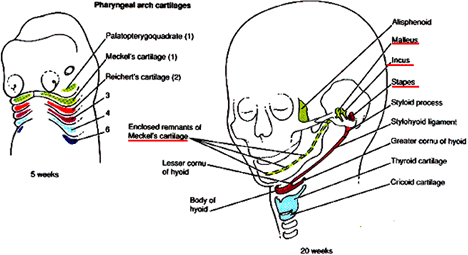
The so-called “yolk sac” is not a yolk at all. It is the source of the human embryo’s first blood cells, and is absolutely required for survival. In chickens, the yolk sac contains much of the food that the chick depends on for growth until it hatches. Humans, on the other hand, grow attached to our mothers via the umbilical, and our mothers nourish us.
Does that mean the “vestigial” yolk sac can be cut off from the human embryo because it isn’t needed? A vestigial organ should be able to be removed with little or no loss of function to the organism. Of course, this is not the case at all.
In an adult, blood cells form inside the bone marrow. This is good design because the blood cells are very sensitive to radiation damage, and bone offers them some protection. In an embryo, you need blood in order to help form the bone marrow that is going to form blood later on in the adult. So, where do you get the blood first? A clever engineer might use a structure similar to the yolk sac in chickens. The DNA and proteins for constructing it are “common stock” building materials. Also, since it exists conveniently outside the embryo, it can easily be discarded after it has served its temporary and very vital function.
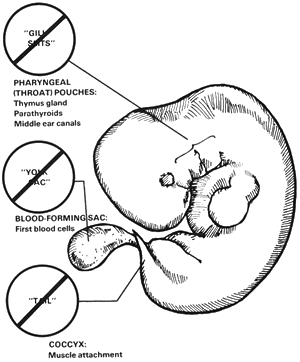 Just as with the so-called gill slits that aren’t gills, the yolk sac in humans is not a yolk or food source as found in an avian egg at all. It bears a passing superficial resemblance and the similarity ends there. Yet text continue to fraudulently link the human embryonic “yolk sac” to our evolutionary past.
Just as with the so-called gill slits that aren’t gills, the yolk sac in humans is not a yolk or food source as found in an avian egg at all. It bears a passing superficial resemblance and the similarity ends there. Yet text continue to fraudulently link the human embryonic “yolk sac” to our evolutionary past.
As to the so called vestigial tail, it isn’t a tail. By day 28 of gestation, the brain and spinal cord has far outpaced the rest of the human baby’s body which causes the fetus to curl up like a letter “C” and this framework serves as the foundation upon which the remainder of the body will form. This gives the end of the spinal cord a superficial resemblance to a tail. You know, like a marble and a bowling ball are both round on the outside, so they must be the same, right?
In reality, it becomes the coccyx, the final bone at the bottom of the human spinal column (after all, the spinal column does have to have an end!) and has nothing whatsoever to do with any prehensile utility. The coccyx bone does serve, however, nine very, very specific other purposes. Various muscles attached to the tail bone are important for facilitating bowel, labor movements, supporting internal organs, locomotion, and keeping the anus closed. If it is broken, it is impossible to move in any direction without pain for years afterward because that bone anchors several of the muscles in the pelvic structure and is an integral part of human mobility. Just ask my wife who broke her coccyx the week after our youngest son came home with us. Without getting too specific, absent that little bone on the end of the spinal cord, you would not ever want to go to the bathroom — not ever.
Even though we call it our “tail bone,” the fact is that there are no vestigial “tails” in human beings. True, rarely, human beings are born with a little fatty tumor or “tag” at the end of the spinal column. This actually has to do with how the central nervous system forms and has nothing to do with being a “throwback” to our so called evolutionary past anymore than mole on your ear is a throwback to a fish scale. Yet biology texts continue to point out our vestigial tail when we are embryos. That is simple fraud.
Fraud in Schools
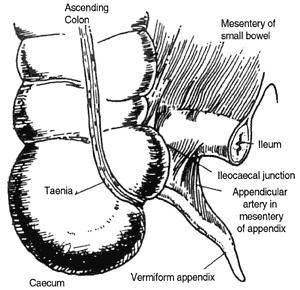 Despite evidence to the contrary, Darwinists textbooks continue to inform students that such things as the nictitating membrane of eye, erector pili (goosebumps), the little toe, nipples on males, the parathyroid, ear muscles for wiggling ears, the pineal gland, body hair, redundant veins, and even the spleen are “vestigial” and proof of evolution. I won’t go through all 180 items ranging from wisdom teeth to the points on some human ears rather tellingly labeled the “Darwin points” by vestigial believers, but suffice to say that each and every one has been shown not to be “vestigial” in human beings by any stretch of the imagination. For a few examples, look at the appendix, tonsils and adenoids, the pineal gland, the thymus, and the spleen.
Despite evidence to the contrary, Darwinists textbooks continue to inform students that such things as the nictitating membrane of eye, erector pili (goosebumps), the little toe, nipples on males, the parathyroid, ear muscles for wiggling ears, the pineal gland, body hair, redundant veins, and even the spleen are “vestigial” and proof of evolution. I won’t go through all 180 items ranging from wisdom teeth to the points on some human ears rather tellingly labeled the “Darwin points” by vestigial believers, but suffice to say that each and every one has been shown not to be “vestigial” in human beings by any stretch of the imagination. For a few examples, look at the appendix, tonsils and adenoids, the pineal gland, the thymus, and the spleen.
- The appendix plays a vital part of the immune system, strategically located at the entrance of the almost sterile ileum from the colon with its normally high bacterial content.
- The tonsils and adenoids serve a similar function at the entrance to the respiratory tract.
- The pineal gland secretes malatonin which is a hormone that regulates the circadian rhythm and sleep cycles and has other functions as well.
- The thymus is part of the immune system, related to T-cells. HIV attacks T-cells, rendering them ineffective and for this reason is always eventually fatal.
- The spleen stores monocytes, white blood cells essential for immune defense and tissue repair. The spleen has a critical role in healing damaged hearts, for instance.
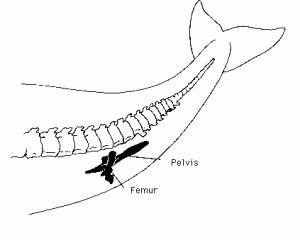 Finding no joy in showing human anatomy to contain vestigial structures, Darwinists quickly moved on to other species such as the appendix of a rabbit, wings on flightless birds, dandelions, sexless lizards, hip bones in snakes, and hip bones in whales. As with the human vestigial structures, good purposes and explanations for all of these exist. For example, the little free floating bones toward the backs of whales are said to be “vestigial” hind legs. In reality, they are kind of important when whales are feeling, well, romantic, and without them there would never be baby whales, for example. Same goes for snakes. Yet textbooks continue to claim these bones are vestigial hind leg bones. That is just plain fraud.
Finding no joy in showing human anatomy to contain vestigial structures, Darwinists quickly moved on to other species such as the appendix of a rabbit, wings on flightless birds, dandelions, sexless lizards, hip bones in snakes, and hip bones in whales. As with the human vestigial structures, good purposes and explanations for all of these exist. For example, the little free floating bones toward the backs of whales are said to be “vestigial” hind legs. In reality, they are kind of important when whales are feeling, well, romantic, and without them there would never be baby whales, for example. Same goes for snakes. Yet textbooks continue to claim these bones are vestigial hind leg bones. That is just plain fraud.
The Truth
I was raised in a very secular way. I held a belief in my heart in God, but I also held onto a belief in the material. For many years, I was an avid Darwinist and I did not allow myself the luxury of critical thought. I accepted as truth the alleged claims of fallible man. I drank the Darwinist kool-aid and asked for seconds. Imagine how duped I felt when I realized that a lifelong hoax had been perpetrated against me.
Then I realized that not only a few frauds had been committed, but literally hundreds. Furthermore, they were known to be frauds by most members of the scientific community. Resorting to fraud time and again should make any rational person question two things. First, the motivation or the agenda that would cause someone to commit the fraud. Second, the point that was being attempted to be made in the first place. Isn’t it true that more often than not a somewhat grand lie props up an even more grand lie?
In my years of recent research, time and time again, real science, critical thought, logic, and facts support the ideas found in a book often referred to as Basic Instructions Before Leaving the Earth — the Bible. Time and time again, truth is sought, truth is revealed, and truth is supported within and by scripture. There is no need for lies, tricks, deception, frauds, forgery, fakery, or mocking to bring anyone to know the truth found there. There is just no need.
God Bless you and yours.
Gregg
Resources: Additional Posts dealing with Creation and Darwinism


Wow,
Tell you what…how about we leave your impressions of my personality out of the discussion, calling someone arrogant and condescending and assuming I feel some sort of pity for creationists has nothing to do with our conversation. I will add however, there was no condescension meant in anything I said, I do not pity creationists.
.
In my post I only did the following:
.
1. Asked you for an alternate naturalistic theory to explain “gill slits”, since you stated that common descent was not the obvious choice and that you thought there most by many other possibilities.
.
2. Asked you to be specific about what children’s textbooks portrayed “gill slits” as gills and referred to them as a “throwback to the fish stage,” , since you made the claim that they exist.
.
3. Darwinism, whatever definition you wish to give it and whether you agree with its conclusions or not, is naturalistic, not supernatural. If all the data in the world pointed to a conclusion that was statistically impossible, until more data or information is learned…science follows the data where it goes.
.
4. Lastly, I asked for some proof to support the implied conspiracy that’s afoot to propagate bad information to students
.
Gregg, I can’t respond to your actual comment because there’s no link there.
.
On your acorn – first of all I wondered exactly what a fossil is, and it seems, by definition, that a six-month old acorn in any condition is not a fossil because it is too young. Wikipedia says something about 10k years or older, so using that definition, by your views I suspect there are no fossils in existence at all. Other definitions may be less specific on dates, but in any case the item has to be very old; a six-month acorn is not a fossil.
A fossil can be of several different types. It can be an actual sample of something, or partly mineralized, wholly mineralized, it can be a cast where minerals fill in a gap that the specimen left in rock before it degraded and was washed away. A fossil can be a trace left by the lifeform, like a footprint or an imprint. So there’s no special condition your acorn would have to have been in to have been a fossil – just old. I assume you mean it was mineralized or covered with minerals or the shell was filled with a mineral deposit?
.
In a way this supports MY point – how many acorns in your yard were mineralized that way? What happened to the other acorns? They were probably carried off and eaten by animals, or crushed or rotted and decayed or sprouted. It was a rare, unique circumstance that that acorn landed in a spot where it was not carried off by a squirrel and where it was mineralized.
.
On the question of mineralization, I have to wonder what kind of minerals were on (or in) that acorn. Are they similar to types of minerals which are found in petrified plant materials? How would they have held up to weathering, crushing, dissolution? Is the mineralization of that acorn comparable to the mineralization in actual fossils? If not, it’s not a useful comparison.
.
(You added Mt, St. Helens; I think I could look that up but I’m not going to do that right now.)
Oh, my apologies. Perhaps I formed my opinion by things you wrote on your own blog. A quick search of just page one reveals such vitriol as, “Sad but true, someone made these cute video’s to try and figure out which of the young earth creationists say the most ridiculous, ignorant and foolish things…”
.
or…
.
“I doubt there is much point is demonstrating that our society of scientifically illiterate children and adults is primarily the result of teaching biblical creation mythologies to our children ”
.
or…
.
“Creationists and those who support Intelligent Design are doing nothing more than trying to advance religious dogma under the guise of scientific inquiry. They want to skip over the vetting process that gives theories their credibility and turn our high school classrooms into the new crucible of scientific truth. Their motives are plain to see, they have no evidence which can stand up to the rigor of peer review and they wish to gain a foothold in the lives of our children by teaching religious ideologies at the expense of good science.”
.
I am not convinced that you are able to compartmentalize the core beliefs you express in comments such as these, but perhaps I am mistaken.
.
That last one, by the way, is a pretty broad accusation. Do you really feel that is my motive as a Christian and a Creationist? If it matters, I DO NOT want Creationism taught in public schools. I do not want ANY religious beliefs taught AS FACT in public schools. That is my primary objection to teaching Darwinism in schools.
.
If it were presented as, “Many believe fish turned into birds by means of slow, gradual, random processes over billions of years” I would have no objection. What objection would you honestly have if it were taught that, “Many believe in a creator or a higher supernatural being who created all living things.” These are presentations of fact, not theory or opinion taught as fact. Very different than proselytizing to children and telling them what they ought to believe. “Fish turned into birds by means of slow, gradual, random processes over billions of years! That is just a fact!” How is that different than, “God created everything.”
.
For the record — I am sure you already know this but I don’t care for equivocation — there is a vast difference between a statistical improbability and a mathematical impossibility.
.
I am glad you made the distinction in point 3 above that Darwinism is naturalistic. Darwinism is very different than science, which is the search for knowledge. Darwinism subverts scientific processes excluding all but the material — strictly speaking it is methodological naturalism. That is hardly science.
.
Let’s say we visit an uninhabited planet in some other solar system and we stumble upon a replica of Mt. Rushmore. Clearly, this rock face was formed at some time in the past and its creation was not observed. Science — real science — would immediately understand that the odds of natural processes designing and creating such a thing are mathematically impossible, well beyond 1050 for example, and therefore good scientists would start looking around for evidence of the designer(s).
.
Darwinists would say, “Isn’t it amazing that wind and rain and sandstorms and lightning and earthquakes altered this rock face and carved out this terrain through small gradual random changes over billions and billions of years so that it looks almost exactly like four human faces?” Now, they might go further. When evidence of the designers is uncovered, they might destroy said evidence. They might perpetrate frauds and hoaxes to support the natural Rushmore2 theory. The wording in textbooks would read, “Natural processes created a mountain that looks remarkably like the designed and created mountain in South Dakota. This is yet more evidence that Darwinism is true.”
.
In other words, good science is not tied to a closed-minded dogma that excludes anything that does not fit nicely inside a rather pronounced philosophical bias. Good science also does not preach, proselytize, or LIE with a pretty clearly stated agenda.
.
As to your questions, please read this coming Sunday’s post which will even include photos. Meanwhile, my questions were —
.
“I would love to see references where macro-evolution has been observed. Yes, please.
.
I would also love to see abiogenesis being observed. Sign me up for that as well.”
.
God Bless,
Gregg
A more accurate term on my part would have been mineralization or permineralization. Strictly speaking, normal human beings cannot use the word fossil as it was originally intended since it has been subverted by the Darwinist world view only to mean mineralized or permineralized artifacts left behind from “ancient” times or “previous geologic ages” so it is now an exclusive word that only fits the Darwinist world view. (Authoritative source M-w online fossil)
.
From a biblical world view, I have seen permineralized cowboy boots with the foot still in it — less than 100 years old. Mineralized and permineralized leaves, trees, small animals etc. in the hydrologically sorted geologic layers laid down by the Mt. St. Helens eruption less than 50 years ago.
.
The only thing that means these, along with my backyard acorn, are not fossils, is the fictional geologic column method of dating.
.
God Bless,
Gregg
You don’t think the word ‘fossil’ includes age? You think it only means mineralization? Do you think the remains from Pompei count as fossils?
I think there are two ideas here that you might be expressing. One is that mineralization can happen quickly, so that it doesn’t in itself indicate great age. I think that’s too simplistic – I think the process of mineralization would depend on the location, the kind of soil covering the remains, the kind of minerals seeping through the area and the pH, things like that. Because mineralization or mineral deposits happen quickly in one situation does not show that it happens quickly in any material in any location.
.
The other idea is that there should be an abundance of transitional fossils because fossilization is easy based on your acorn observation. Again I think this is too simplistic. It ignores the variation in the likelihood of remains in a particular time and location being mineralized (or preserved in another way) and it also ignores the likelihood of the remains being preserved at all – not eaten by scavengers, not crushed, not dissolved, not buried beyond our ability to find it, etc.
Gregg,
I had requested a definition of the word “kind” as used in the Bible to define different classes of living thing. I think it is a necessary requirement before jumping into observed speciation, for me to understand, from your perspective, what the word “kind” actually means.
On a side note – where are you stationed, I take it you are overseas somewhere working as a contractor?
kkemerait, Gregg did respond to your question about kinds. I don’t know if you missed it or if you saw it and didn’t think it answered your question. I’m assuming you missed it, because the comments on this post are getting complicated to follow, It is directly below your comment above asking the question.
hd,
Thanks..I think I found the right section … talking about this Sunday’s posts…yes?
It’s on this post – frauds II. Do a find search; put ‘bring forth’ in the find box.
Greg-
Interesting blog. I was wondering, after spending all the time and energy going back and forth with believers of Darwinist evolution in this particular instance, do you ever entertain the notion that a skeptic, or an unbeliever will never be debated into the kingdom? I suppose there is always a chance they may crack a Bible looking for something to fling back as an aside or a dig, and unwittingly encounter Spiritual revelation – somehow hearing the word and having faith come to them by that hearing. Personally I think I have a better chance of praying someone into the kingdom than skillfully cajoling them with deft responses…especially on subjects that are scientifically way out of my expertise and depth. Just wondering, do you possess a degree in any scientific field of study, or have you educated yourself using resources from Ken Ham and the like?
In Him,
Tim Arnold
Hi Tim.
.
I entertain that notion but I also know that I was once a Darwinist. And I know that biblically we are commanded to always be ready to make an answer for the hope that lives within us.
.
In the interest of brevity, I simply won’t address your stabs at my intelligence, qualifications, or faith; leaving you to read on and use your own best judgement and discrimination about what is and is not “well out of my expertise and depth. ”
.
Thanks for your comment and God Bless,
Gregg
Gregg,
.
I don’t think Tim was taking jabs at you…I think he was speaking of his own abilities and background. At least that’s what he said.
.
Tim,
.
From the other side, I agree with you, that the likelihood of converting someone through a presentation of evidence on biology is unlikely, although I suspect it may help convince people who are already on the fence and are looking for something to help them decide.
.
I was a born-again Christian for 20 years and an atheist for the most recent 25 years, so I have a pretty good sense about how people react and view things from both sides. Typically, most people arguing on blogs are not looking for answers, but, as in my case, are trying to make certain that both sides of an issue are presented.
.
I do not know what Gregg’s background is, although I believe from some comments that his wife made, that he is a software developer (or other related field). I don’t think there is anything inherently wrong with having a debate outside of one’s area of expertise (my own included), as long as both sides are willing to examine the evidence presented and engage in civil debate with integrity and honesty. I have learned a great deal over the years from debating on a variety of subjects as I am sure Gregg has also.
‘
Interesting post, and interesting comments.
I was just wondering, from a critical thinker’s view, what if both creationism and evolutionism (not specifically Darwinian) are both “attempts” of humans at interpreting and explaining the information we receive with our senses?
Does it ever occur to you that maybe both sides of the argument are incorrect? Maybe we will never find the best explanations of things?
What if there is something else? What if there is nothing else?
I am questioning both creationism and evolutionism.
“What if there is something else? What if there is nothing else?”
.
This is essentially a set of questions that are derived from existentialism. The root question that must be answered to address all of these questions is, “Are we really here?” or “Do we really exist?”
.
The answer to these is, of course, yes.